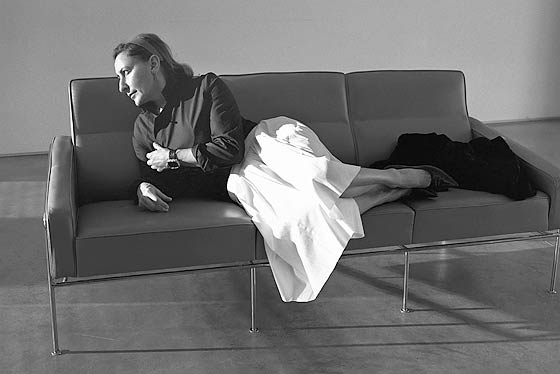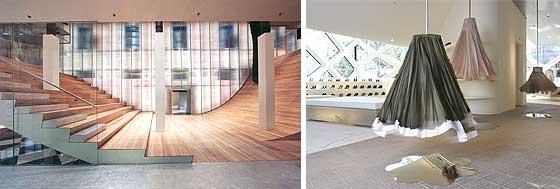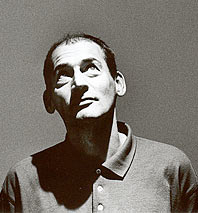
Miuccia Prada doesn’t sound as though she were all that concerned when she heard that her $40 million “epicenter” store, the one that was designed by tetchy avant-gardist Rem Koolhaas and opened in Soho shortly after 9/11, had been ruined by water and smoke damage after a fire. “You know, life is so complicated in general that unless something really terrible happens, I just say, ‘Who cares?’ ” Though, to be honest, she also thought, “Let’s just hope the insurance pays for it and we reopen very quickly.” It took a few months, but the shop, rearranged slightly but otherwise still looking like the world’s most lavish indoor skateboarding ramp, is back. Prada’s here from Milan this week, to reinaugurate it with a mechanized exhibition of her skirts, called “Waist Down,” also designed by Koolhaas’s studio.
Do you come to the city often?
Not in a year. I should, but I have to work, I have a family, I have so many things to do.
Why do you say “should”?
It’s one of the big cities where things happen. Italy is so closed to so many new ideas. New York is still one that’s doing it—at least I hope. What do you think? Do you think it’s too much about money? Shops are where art used to be. It’s the same problem everywhere.
Isn’t the epicenter store supposed to be a sort of art space?
It’s a place for experimentation. But it’s not by chance that the exhibition is in the store. Because it started with the idea of putting more things to discuss, mainly about my work, in the store. It’s like an explanation of the work. It’s not at all anything connected with art. It’s just to make the store more interesting.

Your foundation has sponsored a great deal of art, though, from Vanessa Beecroft to video artist Francesco Vezzoli. Last year some artists even constructed a small Prada store in the middle of the desert in Marfa, Texas.
We had nothing to do with that, except that they asked if they could use our name. And we said yes. Did you like the Marfa store?
Yes! Actually we just did an exhibition with Tom Sachs [an artist who puts luxury-brand names on things like guillotines, toilets, and guns] because he’s another one who approaches the big market and the problem of commerciality.
What do you mean by problem?
Very often I feel very culpable for being a brand. I am very sensitive to the subject. I want to understand myself if I am so bad! [Laughs] I have been reading a lot of [Sachs’s] interviews. In one he talked about how at some point something that was against a brand became a brand—for himself. So everybody wanted this kind of art because it was a brand. And so he decided to not do it anymore. And then he confessed that “sometimes I prostituted myself and did some.” I am aware of all these people who don’t like brands.
What is it about your brand that attracts people?
[Sighs] Yes, it’s difficult to answer. You have some customers who are customers because they understand when you do something clever. For others, the brand is just a brand. It’s just the name—who cares what you do. The two exist together. And when you do things now, you have to do things that people like instantly, so it connects. So you can have a more sophisticated customer and some other who gets the superficial impression. Personally, I’m much more interested in doing things that people all over the world are interested in, instead of only a few sophisticated things for a small group.
What else is the foundation doing?
We are trying to do a new idea of filming, which will be ready in one year.
You’ll be making movies?
I can’t tell you the idea. [Laughs] But we are definitely moving in that direction in art. I am very much interested in art that is accessible to people and is not secluded in a small space, that is more popular in a way. Movies are definitely one. And the Internet is one. But it’s not easy to do something new.
This exhibition was in Tokyo and China before this. How was it received?
Very, very well, mainly in Shanghai. We did the exhibition in an old European hotel on the Bund. It’s completely dilapidated. There is a Communist room, the Russian room, the American room. The exhibition there lasted for just three or four days—they are used to going to an exhibition for just two or three days because so often they get shut down because of the controls. Also, they get bored, I think, so quickly … At the foundation, we’re talking to the Chinese government about a program we have to restore movies; I think they did it because we’re Prada. So I joke with my friend: Maybe we can do more politically with bags than with art. It’s a joke, but there is kind of an interesting point in this globalization argument.

Do you do a lot of business now in China?
We have twelve stores there. But I think it will become very big.
The Soho store opened at the end of the pre-9/11 boom years—a time when you were planning an IPO. Is it different now to run a luxury company?
After September 11, all of the problems—let’s say they were already there—came to the surface. Afterwards, it became more healthy for the company. More reasonable. And now we are doing very, very well.
Is the era of expansion over for Prada? You bought Helmut Lang and Jil Sander, and both designers ended up leaving.
The era of buying companies? I think that maybe [clears throat] it was a mistake, but at the moment you have to more or less do what happens in your business. So that was a kind of common idea that it was possible to be done in the crazy optimism of that moment. In the end it’s not so easy. And also, um, it’s a very complicated subject, and I don’t know that I can say the whole truth about it. It was very difficult for everybody. If we meet privately, I will tell the truth! [Laughs]
What about all these rumors about your working with H&M?
They’ve asked me. I always said no, not because I don’t like the idea, I just don’t like the idea of doing bad copies of what I’m doing. And I don’t have the time, and maybe even the ability, to do a collection with them. If you want to do a collection that costs less, you have to do it with different materials and different ideas.
Why do other people do it?
I don’t know. Because of course they’re attracted by the fame you can get. Just because you want to do something new that people talk about. I don’t know how much real interest there is in doing fashion that is not expensive but is creative.

THE ARCHITECT
Flying Dutchman
Koolhaas fixes up his major New York project.
Globally peripatetic architect Rem Koolhaas touched down here earlier this month to oversee the restoration of his Soho Prada emporium. So far, it’s the biggest thing he’s built in Manhattan (having lost out on the MoMA and Whitney expansions). Miuccia Prada hired him because she was “bored” with her stores and had heard he was intriguingly “difficult.”
After the fire, what changes did you make to the store?
Well, it’s barely redesigned but hopefully more something where you … shop. The ground floor was barely used for shopping, and so we fixed that.
The store’s never really been about maximizing the per-square-foot sale space.
We wanted to be seen to waste space. Which is another form of luxury.
What does doing retail teach you?
We were able to test things that we could apply in buildings for art—the way you address a public, which has to be seductive in the case of a store. So, there is a kind of contamination—in the positive sense.
Speaking of shopping visionaries, you were an adviser at Condé Nast.
After the Internet bubble burst, they asked us to think about Wired and then the larger group [of magazines]. And what we did was create a kind of matrix and looked at where intersections of magazines could spawn new magazines. So, a golf magazine and a fashion magazine, at their intersection you could theoretically have a golf-fashion magazine.
You became famous for your book Delirious New York in 1978. Has this city changed?
Well, that, of course, was never really about New York. It was simply taking New York as the basis for a manifesto. All I can say is in the last 40 years, very few buildings that have the same potential or caliber have been added to the city.
Why is that?
Ummm … no idea. It turns out that very dense, complex cities are not really the thing that this part of the twentieth century was particularly good at.
You’re building a lot in China. Why?
One of the most noticeable things in other parts of the world is that decision-makers are considerably younger than the average important trustee in America. Basically you work for people here who see things as risks that are simply symptoms of progress. The people we’re dealing with in China are, on average, 35 to 43. And that makes a huge difference. What has disappeared here is perhaps an interest in experimentation. You know, you can look at the U.N. building as a radical building at the time.
Do you always wear Prada?
I’m not a poster boy for them.
SEE ALSO:
• Flying Dutchman
Q&A with Soho Prada emporium architect Rem Koolhaas.
• View the label’s latest collections